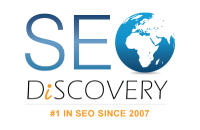Did you know it takes just 0.05 seconds for someone to decide if they like your website or not?
That’s faster than the blink of an eye! And if your site doesn’t look good or load fast, chances are—they’re gone.
A beautiful website alone isn’t enough.
Did you know? Search drives over 1000% more traffic than social media.
So, if your website isn’t showing up on Google, you’re missing out—big time.
That’s why it’s so important to bring SEO and web design together. When your website looks great and is easy for search engines to find, it can attract more visitors, keep them engaged, and turn them into customers.
Whether you’re a small business or a growing digital marketing agency, combining SEO and smart web design is key to boosting your online visibility and driving long-term growth.
In this blog, we’ll show you how combining SEO and smart web design can boost your online visibility and help your business grow.
Table Of Contents
- Why SEO and Web Design Need to Work Together
- Key SEO Friendly Web Design Elements
- On-Page SEO Meets Design: What You Need to Know
- UX Design That Helps SEO
- Local SEO and Web Design
- Image SEO in Web Design
- Content Placement Matters
- Tools That Help SEO + Design Work Together
- What to Ask Before Hiring a Web Design Company
- Why Choose SEO Discovery as Your Web Design and SEO Partner in India?
- FAQs: Combining SEO & Web Design
Why SEO and Web Design Need to Work Together
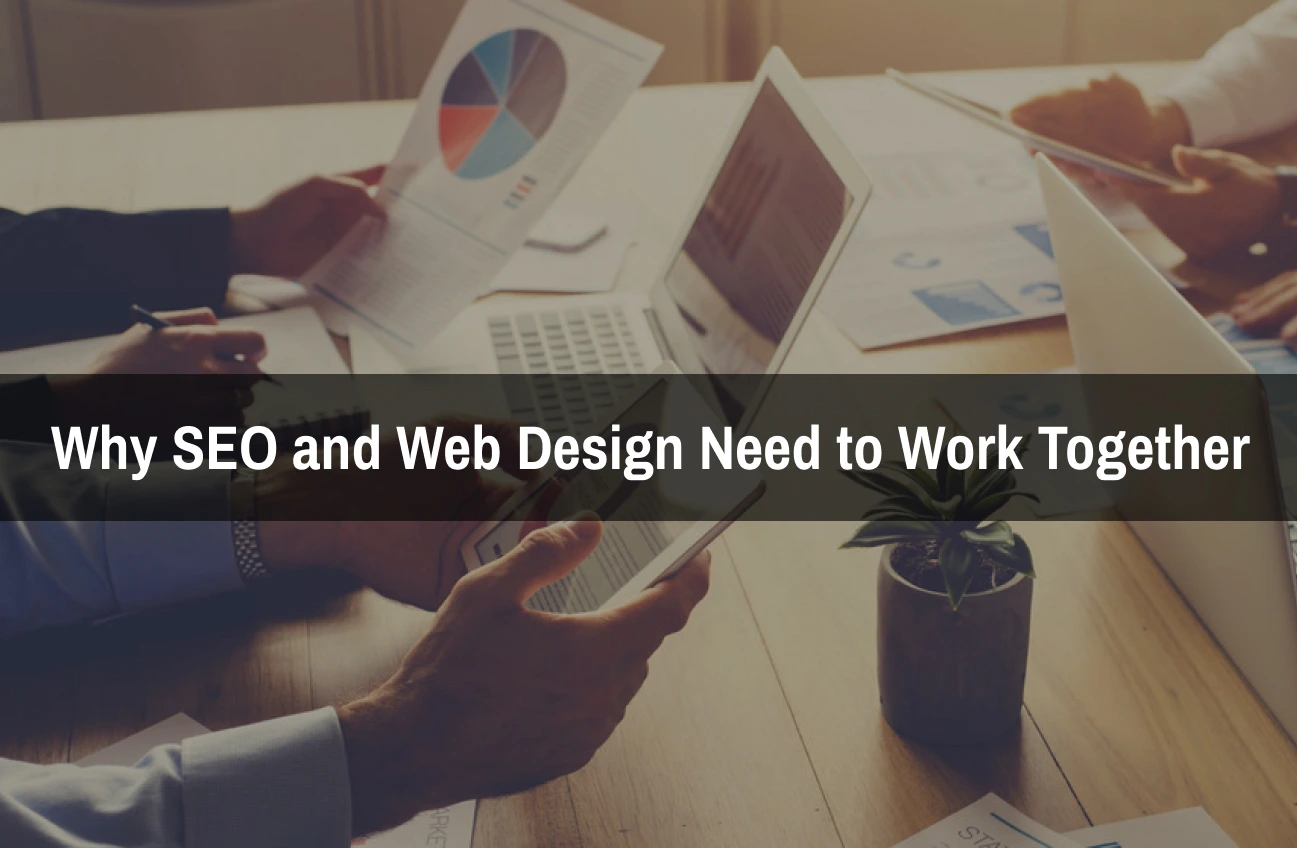
Many businesses treat SEO and web design as two separate efforts, but in reality, they should be integrated from day one. Here’s why:
1. A Stunning Website Won’t Convert if No One Can Find It
You can have the most visually appealing website, but without solid SEO practices, it’s like having a beautiful store tucked away in an alley with no signs. SEO drives the traffic that ensures people find your website in the first place. It doesn’t matter how great your design is if your target audience can’t reach it.
2. SEO Can Bring Traffic, but Poor UX Will Drive Visitors Away
While SEO focuses on ranking your website high in search results, poor user experience (UX) will send visitors running. If your website is difficult to navigate, slow to load, or doesn’t display well on mobile devices, users will leave just as quickly as they arrive. A website designed with SEO in mind ensures smooth navigation, fast load times, and a seamless experience, keeping visitors engaged and likely to convert.
3. Google Cares About Site Speed, Mobile Friendliness, and Usability
Google’s ranking algorithms prioritize factors like site speed, mobile responsiveness, and overall usability—all of which are directly influenced by web design. A website that loads slowly, doesn’t adjust well to mobile screens, or has a confusing layout will be penalized in search rankings. When web design and SEO work together, you ensure that these crucial elements are optimized to help you rank higher on search engines and provide a better experience for visitors.
4. Collaboration Leads to Better Results
If you’re working with a web design company in India or hiring the best web design agency, make sure they understand how SEO impacts design and vice versa. When both teams are aligned, they can create a website that not only looks great but also functions well for search engines and users alike. Integrating SEO into the design process from the beginning leads to better performance, higher search rankings, and more successful conversions.
Don’t Let Great Design Go To Waste—Ensure Your SEO is Just as Strong!
Key SEO Friendly Web Design Elements
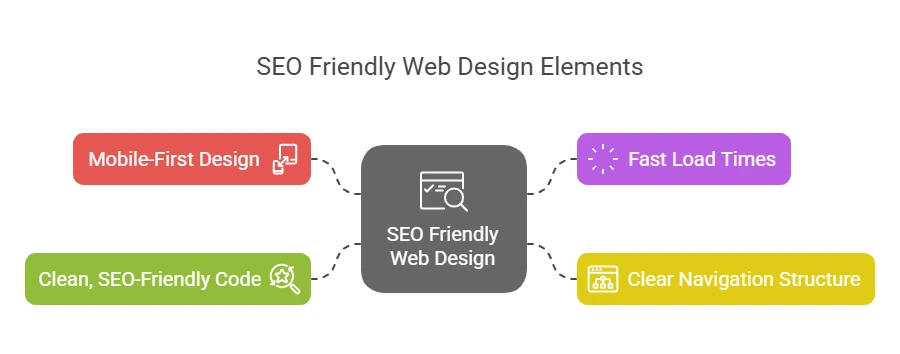
To truly combine the power of SEO and web design, your site should include the following features:
1. Mobile-First Design
Google uses mobile-first indexing, meaning it ranks the mobile version of your site. If your site isn’t responsive, you’re already behind.
A top web design agency will prioritize mobile responsive layouts that look great on every screen size.
2. Fast Load Times
Page speed is a ranking factor. A web design company should optimize your site’s speed by:
- Compressing images
- Minimizing code (HTML, CSS, JavaScript)
Using fast hosting and CDN
3. Clear Navigation Structure
Both users and search engines need to understand your site’s hierarchy.
Use:
- Descriptive menus
- Breadcrumbs
- Internal linking
This makes it easier for Google to crawl your site—an essential part of SEO services.
4. Clean, SEO-Friendly Code
Behind every sleek design should be clean code that helps search engines understand your site.
A Best Web Design Company in India ensures:
- Proper use of header tags (H1, H2, H3)
- Schema markup for rich snippets
- Canonical tags to avoid duplicate conten
On-Page SEO Meets Design: What You Need to Know
To maximize visibility, your site must be optimized on every page. This includes key on-page SEO services such as:
1. SEO-Optimized Headings and Content
Your top web design company should leave space in your layouts for well-written, keyword-rich content.
Place important keywords in:
- Title tags
- H1 and H2 tags
- First 100 words of content
Image alt text
2. URL and Slug Optimization
Search engines read URLs. A clean, keyword-rich URL structure looks like this: www.yoursite.com/seo-services
Make sure your Web Design Agency in India uses SEO-friendly slugs.
3. Meta Tags and Descriptions
Every page needs a unique meta title and description. These influence your site’s CTR (click-through rate) on Google.
Work with a Best Web Design Agency that includes SEO meta fields in your CMS or builder.
UX Design That Helps SEO
Google measures user behavior, and if users stay longer and interact with your site, your rankings improve. Here are key UX elements that directly impact your SEO:
Above-the-Fold Value: Clear, engaging headlines and visible CTAs within the first few seconds capture user attention. Users decide quickly if they want to stay, so make your message clear immediately. This reduces bounce rates and boosts engagement.
Readable Typography: Use large, legible fonts with good contrast and proper spacing for readability. A clean, easy-to-read layout encourages users to engage more with your content. Better engagement signals to Google that your site is valuable.
Interactive Design: Sliders, animations, and hover effects keep users engaged and encourage interaction. Interactive elements show that users are finding your site interesting. The more interaction, the better your SEO performance.
Mobile Responsiveness: Design your site to look great and function well on any device. Google prioritizes mobile-first indexing, meaning mobile-friendly sites rank higher. A smooth mobile experience leads to better user retention and SEO results.
Fast Loading Times: A fast-loading site keeps users happy and reduces bounce rates. Slow sites frustrate visitors and negatively affect SEO rankings. Optimizing images and streamlining design elements improves both speed and user experience.
Local SEO and Web Design
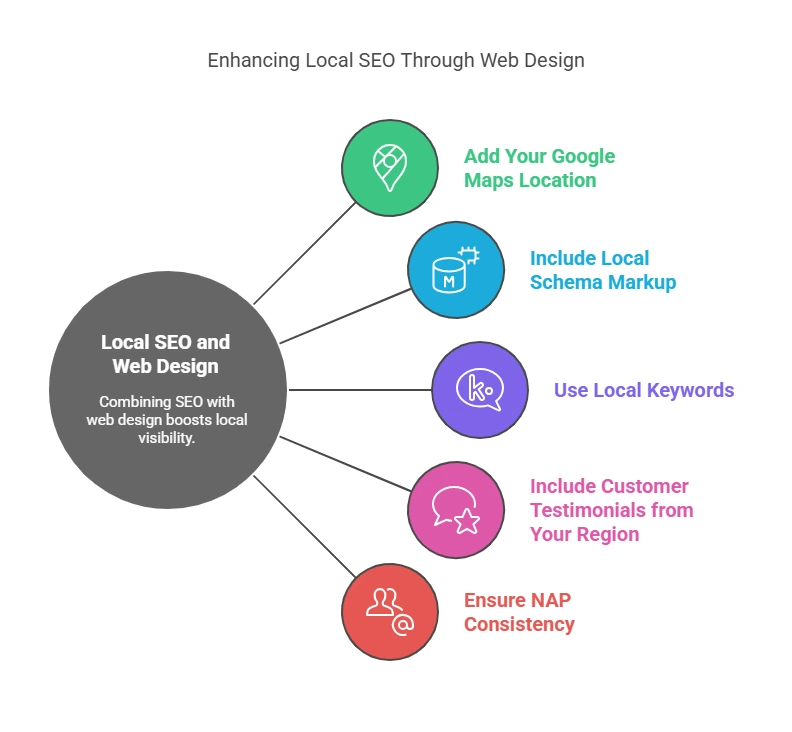
If you’re a business targeting a specific region, combining local SEO services with your web design can significantly enhance your visibility and help you dominate location-based searches. Local SEO is all about showing up in search results relevant to your area, and your website design can play a major role in this process.
Local SEO Design Tips:
1. Add Your Google Maps Location
Embed your Google Maps location on your website to help customers easily find your business. This integration not only provides useful information to your visitors but also signals to Google that your business is tied to a specific location. Including a prominent map or location section—alongside a well-optimized Google My Business listing—can significantly boost your visibility in local search results.
2. Include Local Schema Markup
Adding local schema markup to your website’s code helps search engines better understand your business and its location. This structured data makes it easier for Google to pull accurate information, like your address, phone number, and business hours, which increases the chances of appearing in local search results and Google’s local pack.
3. Use Local Keywords
Integrate local keywords into your content, such as “Web Design Agency in India” or “SEO company near me.” These geo-targeted terms help search engines associate your business with specific locations. Make sure to include them in your headings, titles, meta descriptions, and content for better local search visibility.
4. Include Customer Testimonials from Your Region
Featuring testimonials from local customers can build trust with both your audience and search engines. Local reviews and success stories create credibility and help strengthen your connection to the region. When users see that others in their area have had positive experiences, they’re more likely to engage.
5. Ensure NAP Consistency
Make sure your Name, Address, and Phone number (NAP) are consistent across your website and other online directories like Google My Business. Inconsistent NAP information can confuse search engines and harm your local SEO rankings. Ensuring uniformity across all platforms enhances your site’s local search performance.
Image SEO in Web Design
Images are a powerful design element—but also a great way to boost SEO.
Optimize images by:
- Using descriptive file names: web-design-agency-india.jpg
- Adding keyword-rich alt text
- Compressing files for fast loading
A Best Web Design Company will balance beauty and performance with proper image optimization.
Content Placement Matters
Where you place content matters to both users and Google.
Ensure your Web Design Company structures your content with:
- Headings for scannability
- Bullet points and numbered lists
- CTA buttons placed strategically throughout
When SEO and design work together, your content becomes easier to consume and more effective at converting visitors.
Tools That Help SEO + Design Work Together
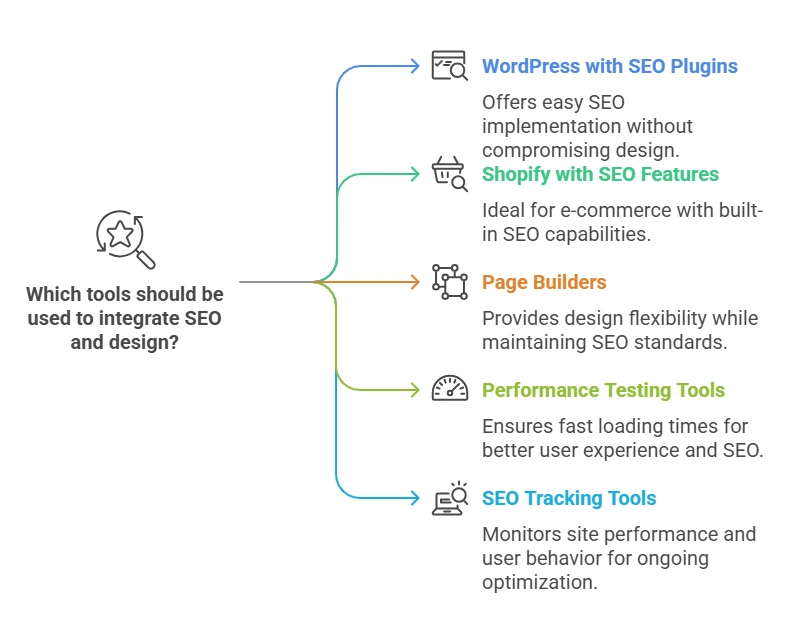
When choosing a top web design company, it’s crucial to ensure they use modern tools that support both SEO and design. These SEO tools not only enhance the design and functionality of your site but also help optimize it for search engines. Here are some key tools that bridge the gap between design and SEO:
1. WordPress with Rank Math or Yoast SEO
WordPress is one of the most popular platforms for building websites, and tools like Rank Math or Yoast SEO make it easy to implement SEO best practices. These plugins allow you to optimize on-page elements, like meta tags, headings, and sitemaps, without compromising the design. They also help with keyword optimization and readability, making sure that both your content and design are SEO-friendly.
2. Shopify with Built-In SEO Fields
If you’re running an e-commerce site, Shopify is a fantastic platform that comes with built-in Shopify SEO features. Shopify allows you to customize meta tags, optimize product pages, and implement SEO-friendly URL structures, all without needing a lot of technical expertise. The platform also ensures your online store’s design is responsive, making it a powerful combo for Shopify SEO and user experience.
3. Page Builders like Elementor, Webflow, or Oxygen Builder
Page builders like Elementor, Webflow, or Oxygen Builder are great tools for web designers who want flexibility in design while still maintaining SEO standards. These tools allow you to create highly customized layouts with drag-and-drop functionality, while also giving you control over SEO elements like meta descriptions, alt text for images, and structured data—all without needing to touch the code.
4. GTmetrix or Google PageSpeed Insights for Performance Testing
A fast-loading website is essential for both user experience and SEO. GTmetrix and Google PageSpeed Insights are powerful tools that analyze your website’s performance and provide detailed insights on what needs improvement. These tools highlight key areas for page speed optimization, such as image sizes, scripts, and server response times, helping you create a faster, more SEO-friendly website.
5. Google Search Console and Analytics for Ongoing SEO Tracking
After your website is live, Google Search Console and Google Analytics are essential tools for ongoing SEO tracking and optimization. Google Search Console helps monitor your site’s performance in search results, identify crawl errors, and track keyword rankings. Google Analytics provides insights into how users are interacting with your site, helping you understand user behavior, which can inform design changes to improve SEO and conversion rates.
What to Ask Before Hiring a Web Design Company
If you’re ready to combine SEO with your website design, ask potential agencies the following:
- Do you build SEO-optimized websites?
- How do you handle mobile responsiveness and site speed?
- Do you include schema, meta tags, and alt text in your process?
- Can you integrate blog pages and landing pages for content marketing?
The Best Web Design Company or SEO company will confidently say “yes” to all the above.
Why Choose SEO Discovery as Your Web Design and SEO Partner in India?
India is home to some of the top web design companies and SEO agencies in the world, and SEO Discovery stands out as the best web design company offering cutting-edge web design and best SEO services. Here’s why businesses globally are choosing SEO Discovery for their web design and SEO needs:
- Affordable Pricing with High-Quality Results
- Skilled Developers and Designers
- SEO Expertise Built into the Design Process
- Full-Service SEO Agency Offering Comprehensive Solutions
- Proven Success for Businesses of All Sizes
With our blend of web design excellence and SEO expertise, we ensure that your website isn’t just beautiful but also highly visible and functional in the competitive digital landscape.
From Design to SEO, We’ll Make Sure Your Website Attracts and Converts!
FAQs: Combining SEO & Web Design
Combining SEO and web design is essential because it ensures that your website is both visually appealing and search engine friendly. A well-designed website alone may not drive traffic if it isn’t optimized for search engines, while an SEO-optimized site with poor design may deter visitors. Integrating both creates a seamless experience that boosts visibility and user engagement.
Web design influences SEO in several key ways. Factors like page load speed, mobile responsiveness, intuitive navigation, and content structure all play a role in how search engines evaluate your site. A well-designed website makes it easier for search engines to crawl and index your pages, which can improve rankings.
Some of the most effective design elements for SEO include mobile-responsive layouts, fast-loading pages, user-friendly navigation, SEO-friendly coding practices, and well-structured content with proper headings. These elements contribute to both user satisfaction and search engine performance.
Mobile-first design is an approach where a website is designed for mobile devices before adapting it to larger screens. This is crucial for SEO because Google uses mobile-first indexing, meaning it primarily considers the mobile version of a website when determining search rankings. A mobile-optimized site provides better user experience and better visibility in search results.
Several tools can aid in merging SEO with design, including website builders like WordPress with SEO plugins such as Yoast or Rank Math, analytics tools like Google Analytics and Google Search Console, speed testing tools like Google PageSpeed Insights, and performance trackers like GTmetrix. These tools help monitor and enhance both design and optimization efforts.
When speaking with a web design agency & SEO agency, you should ask about their experience with SEO-friendly website structures, how they optimize for speed and mobile responsiveness, their approach to implementing meta tags and schema markup, and whether they support ongoing content optimization through blogs or landing pages.
Yes, user experience (UX) plays a significant role in SEO. Google favors websites that keep visitors engaged. If your site loads quickly, is easy to navigate, and encourages users to stay longer, it improves your site’s dwell time and reduces bounce rates—factors that can positively influence your SEO rankings.
Hotlinking happens when other sites use your images, which takes up your bandwidth and slows your site down. To stop hotlinking, you can add a line of code to your website’s settings or use a security plugin to block it.
